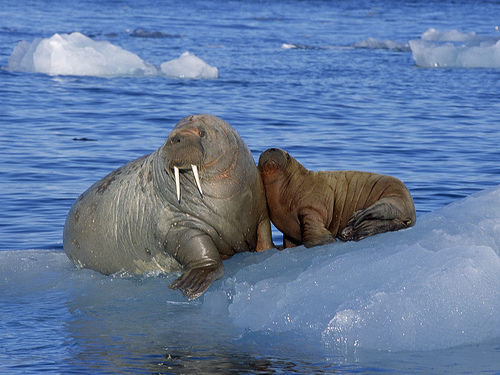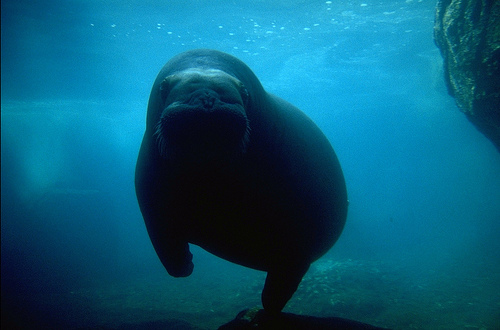SERIOUS MUSTACHES
 (Image credit: Flickr user Chrissy Wainwright)
(Image credit: Flickr user Chrissy Wainwright)
For fashionable men like Geraldo Rivera and Wilford Brimley, giant mustaches are mere frills. But for the walrus, whiskers are a matter of life and death. The long hairs of a walrus’ mustache are actually delicate instruments, bristling with nerve endings. Walrus use them to detect shellfish hidden on the ocean floor, where the animals consume as much as 120 pounds of food a day. Wilford Brimley’s mustache has never seen that much seafood, even in its prime.
YOU CAN’T HANDLE THE TOOTH
 (Image credit: Flickr user Lindsay Robinson)
(Image credit: Flickr user Lindsay Robinson)
Walrus tusks are actually modified canine teeth that can grow up to 3 feet long. The walrus uses its tusks to hoist itself out of the water and onto the ice-an ability that earned it the scientific name Odobenidae, Greek for “tooth walker”. But these teeth weren’t just made for walking. They can dig into an ice floe, anchoring the walrus so it doesn’t drift away in its sleep. The Tusks work as weapons, too. While mostly used to settle disputes between male walruses, the tusks also protect against predators; even the deadly polar bear steers clear of the tooth walker.
LEGEND OF THE LEFT-HANDED WALRUS
A few years ago, a team of very patients researchers off the coast of Greenland observed the way walruses snacked on shellfish. As the walruses used their flippers to clear away ocean muck to find clams, the scientists noticed that they overwhelmingly favored their right sides. In fact, a left-handed walrus has yet to be seen.
BIG BONED
 (Image credit: Flickr user flikkerphotos)
(Image credit: Flickr user flikkerphotos)
The male walrus has a penis that’s actually worth bragging about. It contains a bone within the erectile tissue called a baculum. Bacula are common in mammals (humans are a rare exception), but what sets the walrus apart is that its baculum can grow as long as 30 inches. And they’re expensive. In 2007, a fossilized 4 foot baculum from an extinct walrus species sold at auction for $8,000.
BLUSHING BEAUTIES
 (Image credit: Flickr user Mike Liu)
(Image credit: Flickr user Mike Liu)
In the water, walruses are brown, but in the sunlight they become a rosy shade of pink. It’s not a sunburn, as early observers thought, but rather a change in the way blood circulates through the animal’s body. When the walrus is in the ocean, its blood retreats to its core, keeping the vital organs warm. On land, however, the blood returns to walrus’ outer layers, giving it a healthy, sun-kissed glow.
THE ONE-MAN FLOATING BAND
 (Image credit: Flickr user Steve McNicholas)
(Image credit: Flickr user Steve McNicholas)
When courting a lady walrus, the guys aren’t afraid of a little song and dance. In fact, a male walrus will elaborately click, bark, and drum his flippers on his pharyngeal pouches-two air pockets on the sides of his throat-creating music so complex it’s been compared to the songs of humpback whales. On land, this pouch-drumming isn’t so impressive, but underwater, it sounds like chimes. In fact, when marine explorer Jacques Cousteau visited the Arctic in 1972, he dropped a microphone into the ocean and mistook the ringing for bells. In addition to making music and impressing French divers, pharyngeal pouches also serve as flotation devices, allowing walruses to comfortably float and sleep with their necks above water. They’re like water-wings, except in your neck.
__________________________
 The above article was written by Isaac Kestenbaum. It is reprinted with permission from the Scatterbrained section of the September-October 2010 issue of mental_floss magazine.
The above article was written by Isaac Kestenbaum. It is reprinted with permission from the Scatterbrained section of the September-October 2010 issue of mental_floss magazine.
Be sure to visit mental_floss‘ entertaining website and blog for more fun stuff!

No comments:
Post a Comment